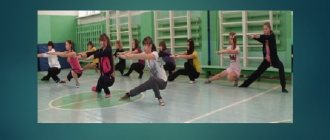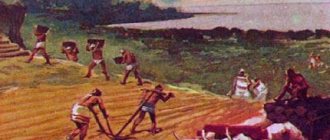Simple rule
“Everything ingenious is simple,” this saying is perfect for the precise and correct method of constructing a human figure (character) in motion. The essence of this method is that we initially begin to build a person from the lines “stick, stick, cucumber, it turns out to be a little man,” and then we add the shape of the body to this simplified skeleton.
Example:
Figure No. 1.
Stages of drawing a character A small clarification: the very first line on your sheet should reflect the pose, the action of the person (bending, tilting, posture). If necessary, guides for arms or legs can be added to this line.
Rice. No. 2. First sketches
Drawing a character in motion is always interesting; there is something to learn and strive for. Standing, sitting, moving, a person must maintain balance, balance the weight of his body so as not to fall. There are two main centers of mass that have to be constantly balanced with each other: the mass of the torso and pelvis . The head is usually held straight, and the arms and legs help maintain balance and serve as supports.
To stand straight, people tilt their chest slightly back and their pelvis forward . This is especially clearly visible if you look at the figure in profile. We need to define one term that will be useful to us: The jugular fossa is a depression on the collarbone, it is marked with a red dot in further illustrations for this article. In fact, the jugular fossa is the center of gravity of the human body. In a straight stance, everything is simple, the weight of the body is evenly distributed on both supports - the legs, and the jugular fossa is located directly above the fulcrum.
Rice. No. 3. Character's center of gravity
Pay attention to how the vertical line runs from the jugular fossa to the support when looking at the person in profile. It also divides the body mass into two equal parts, although in this position it is not as clearly visible as in the front view.
Tip 4. Practice. Draw sketches
Drawing in class, from photos, and from life “builds” different skills and helps you understand form in different ways.
Go outside and draw. Drawing from life is an extremely useful observational tool. It doesn't matter where you sketch - in a classroom or at a local cafe. By studying the people around you, you will learn to draw a person's figure and his mood.
It's a good idea to take a live drawing class. Typically, they include both long and short sketches. Longer ones (10-15 minutes) allow you to capture details and study human anatomy, while faster ones (2-5 minutes) are more suitable for studying the technique of depicting gestures.
Note ed. In this video, famous artist and animator Stefan Silver explains what guides his sketches from life.
One leg emphasis
If a person stands leaning on only one leg, the center of gravity shifts to this support. The jugular fossa will be directly above the supporting leg . In this position, the mass is distributed differently, taking into account the fact that the supporting leg supports most of the body's weight.
Rice. No. 4. Jugular fossa in motion
In drawings and paintings, there is often much more emphasis on the supporting leg, and much less emphasis on the other leg. Thus, emphasizing the support and balance of the figure.
Image of a ski jumper
Before drawing, it is recommended to consider the athlete's pose. When jumping from a springboard, the skier concentrates, squats, tilting the upper body forward. The line of the figure takes on the shape of a zigzag. The legs in this position are usually parallel to each other, and so are the skis. Sticks are drawn horizontally.
- The athlete's head is depicted in a round shape; a mask is drawn over the eyes.
- The arm is extended towards the viewer, so its length is shortened - this is according to the rules of projection. The stick should be positioned at a very slight angle to the skis; you can even draw it parallel to the skis.
- The back line runs at an angle of 45 degrees to the horizontal. Of course, the back itself should be drawn rounded, and not completely straight. The line of the femur and the line of the back form an angle of approximately 60 degrees. The leg is drawn at the same angle after the knee bend.
- Since the artist depicts the skier as if from below, the ski should not be drawn exactly horizontally, but with a slope of approximately 30 degrees.
- The second ski is depicted parallel to the first.
- If the artist decides to make a drawing in color, then you can make a highlight on the glasses with a stripe.
To become a real artist, you need not only to have natural abilities, but also to study a lot of drawing theory. In order to depict an athlete, the draftsman should study the structure and proportions of the human body. Studying the works of masters can help in acquiring drawing skills. And the most important condition: practical training for an artist is just as important as daily training for an athlete.
Additional support
If you need to depict a person leaning on something, keep in mind that in this position the center of gravity will be between two supports. For example, consider the figure below:
Figure 5. Additional support
- The man leaned against the wall. There are two supports here: the legs and the wall. The vertical line from the jugular fossa (center of gravity) descends between the wall and the legs.
- The figure leaned over the bar counter. There are two supports: the table and the right leg. The vertical from the jugular fossa descends in the middle between these two supports.
- An old man leans on a cane to distribute the weight of his body over more points. The center of gravity (jugular fossa) is between them.
In a sitting position
When a person sits, the main support point is the pelvis. Let's look at the illustration, green :
Fig 6. Character in a sitting position
- To maintain balance while sitting and leaning forward, you need an additional point of support for your torso. For example, a table or elbows on your knees.
- If you want to lean back, you will have to lean on the back of a chair, sofa, or put your arms back, resting on your palms.
- Another example: while sitting, balance can be maintained with both hands, one stretched forward to the knee, the other back, instead of the back of the chair.
Loaded
A person carrying any additional weight must take such a position that the weight of his body and the load are in balance. The reference point in this case will be located between the jugular fossa and the center of mass of the load, and will coincide with the supports (legs). Let's look at the illustration: the center of gravity of the human body is marked in red the center of gravity of the load in blue in green .
Fig 7. Character with cargo
- For example, a person carrying a heavy basin of water in front of him must lean back as the burden pulls him forward. The mass balance point is at the level of the feet.
- If you need to portray Santa Claus with a very heavy bag of gifts over his shoulders, you need to tilt him forward so that under the gravity of the bag the grandfather does not fall back. The balance point of the masses (bag and grandfather) will be located between both supporting legs.
- A pregnant woman also has an additional burden - a belly with a baby. In the last stages, this load is so large that the woman needs to lean back a little with her body to maintain balance, since the weight of the abdomen pulls forward.
The heavier the burden, the more the person (character) carrying it must bend. The person leans in the direction opposite to where his load is located . In fact, there are a huge number of examples!
Tip 5: Practice again. Draw Gestures
A gesture can be sketched in a short period of time. There is no need to take into account all the nuances - the main thing is to convey the pose.
Illustrating a gesture is a quick way to capture a figure “in general.” Such observational drawings are often completed in a very short period of time—in a life drawing class, the model may only pose for 30 seconds so that the artist can record his first impressions on paper.
When creating thoughtful, quick lines, try not to worry about how the work looks or go into detail. You must focus on action and sensation.
Editor's note Stanislav Prokopenko aka Proko has a series of cool lessons on drawing gestures on his Youtube channel. You can start here:
And here you can open and hide photographs of posing models using a timer to practice drawing gestures. Straight from home! You can select the type of photo (portrait, landscape, body parts, etc.), gender, amount of clothing and workout time.
Body in motion
Walking
To describe walking in a simplified way, it is pumping from side to side, or a controlled fall. Hands in motion help maintain balance. The legs are supports that change alternately. When walking, the pelvis and chest tilt in opposite directions.
Fig 8. Drawing while walking
Run
How to draw a running man? To create even greater dynamics of movement and run forward quickly, a person is forced to tilt his torso forward. Since the center of gravity (torso and jugular fossa) is tilted forward, a person can either fall or substitute support (leg). This is how we run, throwing our torso forward and placing our supports (legs), and our arms help us move faster with their movements.
Fig 9. How to draw a running man?
In the illustration above: the center of gravity is marked in red the direction of movement is marked with a blue in green . The faster you need to move forward (run), the more you need to throw your center of gravity forward, the wider your step becomes, and the more sweeping your arm movements become.
Dynamic movement of the torso and arms
To create a drawing of a person in some pronounced dynamic movement, you need to subordinate the entire body of the character to this movement. In such cases, the center of gravity shifts greatly in the direction of movement, and the whole body must be placed on very reliable supports - legs widely spaced.
For example,
- The boxer throws a forward punch with his right hand while standing on two legs. To do this, he adopts a very well-balanced position, leaning on both legs. When swinging, the entire mass of the torso and strength are transferred into the blow.
Fig 10. Sweeping movements - The same thing happens when a person swings a sword or a baseball bat with a racquet in his hands.
To balance when the torso and arms are very mobile, it is tedious to find a good point of support, but it is better to play it safe and stand confidently on both legs.
The basis of auxiliary constructions when depicting the human figure
Not everyone knows how to draw an athlete with a pencil step by step. Therefore, in order for a person to be proportional, before starting to draw, you should make additional constructions - sketch out the “skeleton” of the image using hair lines. Since drawing an athlete means, first of all, depicting a person in motion, the basic rules of proportion of the human body must be strictly observed.






